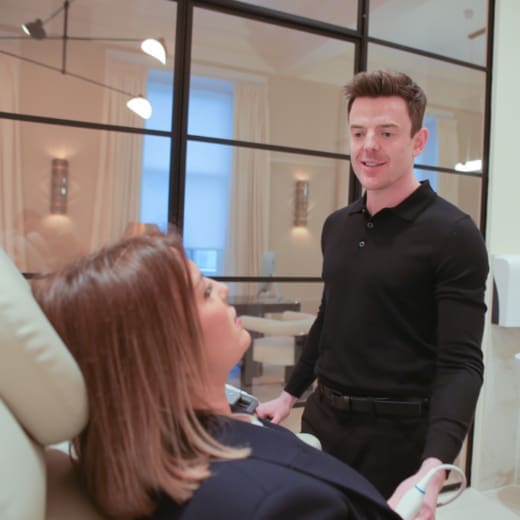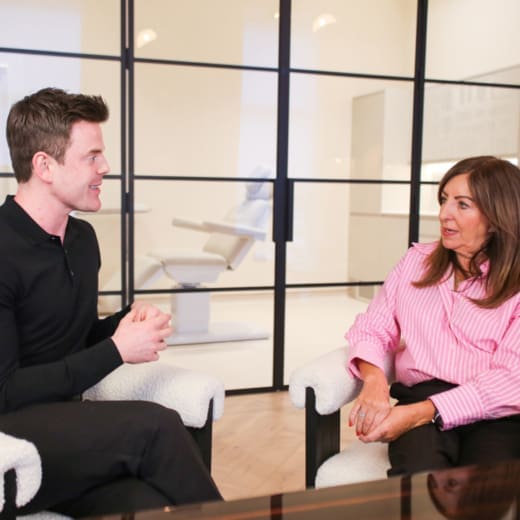McKeown Medical
167 Bath Street, Glasgow, G2 4SQ
Date posted — 5.10.24
As always in medicine, the best treatment is prevention – which means avoiding the sun as much as possible and covering up and protecting the skin with SPF when it’s not possible to avoid sun exposure.
But let’s assume you maybe take care of your skin now, but you weren’t so good in your younger years, and you’ve got some historic sun damage that you want to get rid of.
How do you go about getting rid of that old sun damage on the face and body?
The mainstay of treating sun damage is laser treatment, and there are three main categories of lasers you can use to treat sun damage.
The first category is ablative – which means that it removes tissue from the surface of the skin.
The ablative lasers can then be subdivided into fully ablative lasers – which remove the entire surface of the skin – and fractional ablative lasers, which remove only a fraction of the skin’s surface.
The final category is the non-ablative lasers, which don’t remove any tissue from the skin’s surface.
Let’s start with the non-ablative devices.
My favourite non-ablative way to treat sun-damaged skin anywhere on the body (we most commonly treat it on the face, but we can treat it pretty much anywhere on the body) is broadband light.
Ok, so technically, this is not a laser because it uses more than one wavelength of light. But let’s forget about the physics and think of it as a laser.
Broadband light (BBL) is an excellent technology for shattering pigments in the skin, which gets rid of the brown spots or age spots or areas of hyperpigmentation if we want to use their technical name.
BBL is also excellent for reacting with the red pigment in blood vessels, causing the blood vessels to close down and clear patches of redness.
It is also an excellent stimulator of collagen renewal, improving the organisation of collagen and elastin fibres in the skin, which, over time, improves the texture of the skin’s surface.
BBL is by far and away my favourite treatment to prescribe in the clinic because pretty much anyone over the age of 30 benefits from it. There is usually no downtime at all, and it’s a relatively gentle treatment you can repeat every six months or so to keep your skin in great shape.
If you have more severe changes to the texture of the skin, particularly with fine lines and wrinkles then we need to think about adding in some ablative laser resurfacing.
When the texture changes are more than we can deal with non-ablative laser treatment but not quite severe enough for full resurfacing, then a fractional ablative device is our go-to.
For this, I love the Halo laser from Sciton.
The unique thing about this device is that it combines two different lasers (one ablative and one non-ablative) that fire at the same time, meaning you can target different layers of the skin simultaneously.
We tend to be pretty aggressive in our approach with this, so most patients can expect 5-7 days of downtime, but when your skin is healed, you get the famous ‘Halo Glow’ and continued improvement in the surface of the skin for a few months later.
For the most severe sun-damaged skin with deep lines and wrinkles that are really etched into the surface of the skin, however, we need to get out the big guns – the fully ablative laser.
This removes the entire surface of the skin so that the skin grows back like new again.
It’s an extremely effective treatment that can get rid of even the most stubborn wrinkles, however it is also the most invasive option that most people want to avoid.
For that reason, not many clinics offer this treatment, but for some patients, it’s just the right treatment and the only one that will give them the results they are looking for.

When it comes to your health, few things are more important than taking care of your gynaecological wellbeing. Yet many...

Varicose veins are more common in women than men. While many people associate these bulging, twisted veins with ageing or...

When you're trying to conceive, it's natural to focus on your ovulation cycles, hormone levels, and lifestyle habits. However, one...
1 / 3
2 / 3
3 / 3

When it comes to your health, few things are more important than taking care of your gynaecological wellbeing. Yet many...

Varicose veins are more common in women than men. While many people associate these bulging, twisted veins with ageing or...

When you're trying to conceive, it's natural to focus on your ovulation cycles, hormone levels, and lifestyle habits. However, one...
With darker evenings and fewer social engagements, January is a great time to think about treatments which benefit from a little down time or those that will deliver their best results by spring.
Here’s Dr Darren with his top recommendations for treatments to have over the winter months, including Sofwave, HALO, full-field resurfacing and varicose vein treatment, all of which will deliver beautiful results in time for the weather getting better and social calendars filling up!
Which treatments are you planning?

Another year, another round of incredible transformations from our team at McKeown Medical!
Eye bags banished, jowls lifted, skin refined, veins gone. Thank you so much to all of our patients who have allowed us to share their photos with you and thank you to our incredible team who work so hard to take care of every patient who trusts us with their care.
Here’s to 2026 and another year of incredible transformations!

“But Daddies, WHEN is Santa coming? I want to wait up for him!”
Happy Christmas to all, and to all a good night 🎅🏻

Laser rejuvenation of the eye area can be an incredibly powerful tool for the right patients, especially those whose ‘bags’ are more about loose skin and fine lines, like this lovely patient here.
We treated her with full field ablation, which takes around 2 weeks to recover from. Her she is a few weeks later and you can see how much tighter the skin is, the crepey skin has gone and the fine lines have been ironed out. The patient is over the moon.
What do you think?

Eyelid surgery is one of the most popular procedures we do in the clinic. It’s a great fix for hooded eyes! Excess skin on the upper eyelids can not only create a hooded, heavy appearance but often affects the vision too.
Here’s the very talented @bramhallplasticsurgery discussing how upper eyelid surgery (blepharoplasty) can restore a more open, refreshed look by removing the excess skin and subtly redefining the natural eyelid crease. Scars are hidden within the fold of the eyelid, leaving eyes that look brighter, not “done.”
Do you have any questions about surgery? Ask in the comments or send us a message!

Thank you to our patient for allowing us to share her before and after photos of her upper blepharoplasty.
Excess skin on the upper eyelids can make the eyes appear tired or heavy. This simple procedure restores a lighter, more open look while keeping the result completely natural.
Another fabulous result from the very talented @bramhallplasticsurgery!
What do you think?

We’ve been in our new home for a year now and I thought this would be a good time to remind you just how special it is with a little video tour.
It’s been a remarkable year for us in our new home; we’ve introduced new doctors, new treatments, new services and our team continues to grow from strength to strength - always striving to provide more and better for our wonderful patients.
Enjoy the tour!

About last night… It was time once again for our annual Christmas celebration with this absolute bunch of legends. We were a little earlier than usual this year so we could have has many people available as possible, and the evening did not disappoint.
A few sore heads this morning, but absolutely worth it to celebrate the hard work this team dedicate to our patients day in, day out all year round. I am very proud to have the undisputed best team on the planet. Merry Christmas everyone! 🎄

Fine lines etched into the skin around the mouth - this is a common problem and in this patient`s case she had what we call ‘actinic elastosis’, whereby abnormal bands of elastin build up in the skin as a result of years of previous sun exposure.
When patients have this condition, the gold standard way of dealing with it is fully ablative laser resurfacing. It’s an intense treatment with two weeks of downtime afterwards, but the results are spectacular - just like in this lovely patient.
The after photo is three weeks after the treatment and you can see that the skin is still a little pink, which will continue to fade over the next few months.
The patient is already delighted with the result - what do you think?
